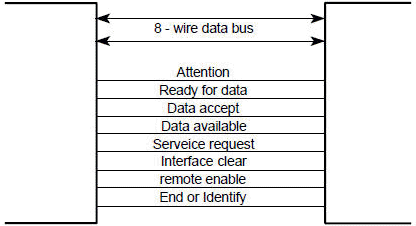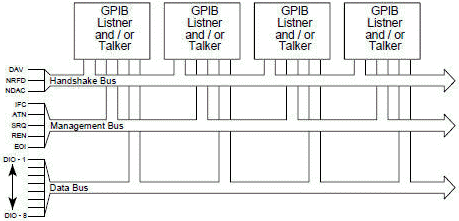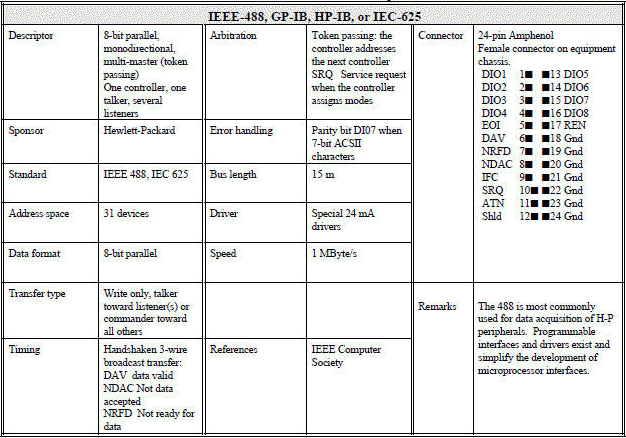Electronic Warfare and Radar Systems Engineering Handbook |
||||||||||||||||||||||||||||||||||||
|
IEEE-488 INTERFACE BUS (HP-IB/GP-IB) In the early 1970's, Hewlett-Packard came out with a standard bus (HP-IB) to help support their own laboratory measurement equipment product lines, which later was adopted by the IEEE in 1975. This is known as the IEEE Std. 488-1975. The IEEE-488 Interface Bus (HP-IB) or general purpose interface bus (GP-IB) was developed to provide a means for various instruments and devices to communicate with each other under the direction of one or more master controllers. The HP-IB was originally intended to support a wide range of instruments and devices, from the very fast to the very slow.
Description: The HP-IB specification permits up to 15 devices to be connected together in any given setup, including the controller if it is part of the system. A device may be capable of any other three types of functions: controller, listener, or talker. A device on the bus may have only one of the three functions active at a given time. A controller directs which devices will be talkers and listeners. The bus will allow multiple controllers, but only one may be active at a given time. Each device on the bus should have a unique address in the range of 0-30. The maximum length of the bus network is limited to 20 meters total transmission path length. It is recommended that the bus be loaded with at least one instrument or device every 2 meter length of cable (4 meters is maximum). The use of GP-IB extenders may be used to exceed the maximum permitted length of 20 meters. Electrical Interface: The GP-IB is a bus to which many similar modules can be directly connected, as is shown in Figure 1. A total of 16 wires are shown in the figure - eight data lines and eight control lines. The bus cables actually have 24 wires, providing eight additional for shielding and grounds.
Figure 1. IEEE-488 (HP-IB/GP-IB) Bus Configuration The GP-IB defines operation of a three-wire handshake that is used for all data transfers on the bus. The bus operation is asynchronous in nature. The data-transfer rate of the GP-IB is 500 kHz for standard applications and can go up 1 MHz if special conventions are followed. Each transaction carries 8 bits, the maximum data bandwidth is on the order of 4 to 8 megabits (1 M byte) per second. The bus is a two way communications channel and data flows in both directions. Figure 2 illustrates the structure of the GP-IB bus and identifies the 16 connections of the interconnecting cable.
Figure 2. GP-IB Instrumentation Bus Structure
The cabling limitations make it a less-than-ideal choice for large separation between devices. These limitations can be overcome with bus extenders. Those attempting to use bus extenders should be aware that few extenders are as transparent as claimed. This is especially true in handling of continuous data and interrupts. In nonextended environments, it provides an excellent means for high-speed computer control of multiple devices. The following table shows the various interface functions, the mnemonics and the descriptions. Table 1. GP-IB Interface Functions
The cabling specifications of the GP-IB interface system permit interconnecting all devices together in a star or linear configuration. The GP-IB connector is a 24-pin ribbon-type connector. In summary, Table 2 on this page and the next shows the complete description of the GP-IB data bus.
Table 2. GP-IB Data Bus Description
Since introduction of the IEEE-488, technology produced a generation of medium-speed, low-power, instrumentation which had a need to operate in an automatic test system such as the GP-IB. The HP-IL (Hewlett-Packard Interface Loop), was introduced to meet this need. The HP-IL is a low-cost, low-power alternative to the GP-IB system. The HP-IL and GP-IB provide the same basic functions in interfacing controllers, instruments, and peripherals, but they differ in many other respects. HP-IL is suitable for use in low-power, portable applications ( typically used for interface of battery-power systems ). The GP-IB is not practical to operate from battery power. The HP-IL maximum data rate is 20K bytes per second. This is a high rate compared to the RS-232C, but much slower than GP-IB. The HP-IL can operate over distances of up to 100 meters between any two devices. Since it is a loop environment, there is no maximum system cable restriction. The basic device-addressing scheme allows for up to 30 devices on a loop.
Table of Contents for Electronics Warfare and Radar Engineering Handbook Introduction | Abbreviations | Decibel | Duty Cycle | Doppler Shift | Radar Horizon / Line of Sight | Propagation Time / Resolution | Modulation | Transforms / Wavelets | Antenna Introduction / Basics | Polarization | Radiation Patterns | Frequency / Phase Effects of Antennas | Antenna Near Field | Radiation Hazards | Power Density | One-Way Radar Equation / RF Propagation | Two-Way Radar Equation (Monostatic) | Alternate Two-Way Radar Equation | Two-Way Radar Equation (Bistatic) | Jamming to Signal (J/S) Ratio - Constant Power [Saturated] Jamming | Support Jamming | Radar Cross Section (RCS) | Emission Control (EMCON) | RF Atmospheric Absorption / Ducting | Receiver Sensitivity / Noise | Receiver Types and Characteristics | General Radar Display Types | IFF - Identification - Friend or Foe | Receiver Tests | Signal Sorting Methods and Direction Finding | Voltage Standing Wave Ratio (VSWR) / Reflection Coefficient / Return Loss / Mismatch Loss | Microwave Coaxial Connectors | Power Dividers/Combiner and Directional Couplers | Attenuators / Filters / DC Blocks | Terminations / Dummy Loads | Circulators and Diplexers | Mixers and Frequency Discriminators | Detectors | Microwave Measurements | Microwave Waveguides and Coaxial Cable | Electro-Optics | Laser Safety | Mach Number and Airspeed vs. Altitude Mach Number | EMP/ Aircraft Dimensions | Data Busses | RS-232 Interface | RS-422 Balanced Voltage Interface | RS-485 Interface | IEEE-488 Interface Bus (HP-IB/GP-IB) | MIL-STD-1553 & 1773 Data Bus | This HTML version may be printed but not reproduced on websites. |
||||||||||||||||||||||||||||||||||||


